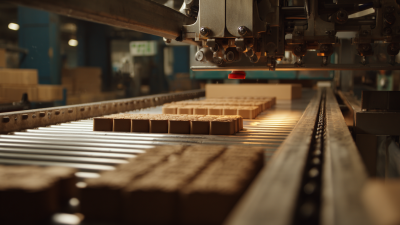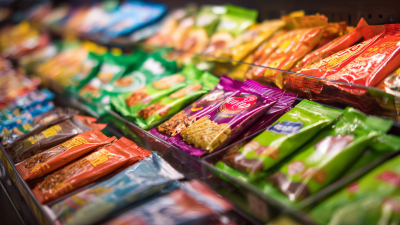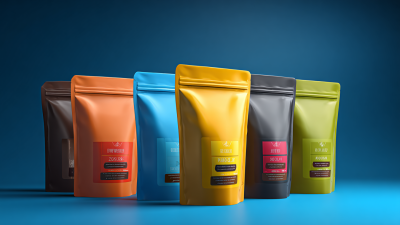- CUSTOM BOXES
- CUSTOM BAGS
- CUSTOM STICKERS
Understanding the Rising Demand for Sustainable Packaging Supplies in E Commerce Trends
As e-commerce continues to flourish, the demand for sustainable packaging supplies has skyrocketed, driven by both consumer preferences and regulatory pressures. According to a report by Smithers Pira, the global market for sustainable packaging is projected to reach $1 trillion by 2027, with a compound annual growth rate (CAGR) of 11% from 2022 to 2027. This paradigm shift not only reflects an increased awareness of environmental issues among consumers, with 73% stating they prefer brands that use eco-friendly packaging, but also highlights retailers' commitment to reducing their carbon footprints.

Additionally, the Sustainable Packaging Coalition notes that over 61% of consumers are willing to pay more for sustainable materials, prompting e-commerce businesses to reevaluate their packaging strategies. In this context, understanding the intricacies of sustainable packaging supplies becomes imperative for brands aiming to enhance their market appeal and align with evolving consumer expectations.
Sustainable Packaging: The New Standard for E-Commerce Success
 The rise of e-commerce has triggered a significant shift in consumer expectations, leading to sustainable packaging becoming a crucial standard for businesses aiming for success. As eco-consciousness grows among consumers, companies are recognizing the importance of incorporating environmentally friendly materials into their packaging strategies. This shift not only aligns with consumers' values but also enhances brand loyalty and reputation. Businesses that prioritize sustainability in their packaging are more likely to attract and retain customers who are increasingly making purchasing decisions based on environmental impact.
The rise of e-commerce has triggered a significant shift in consumer expectations, leading to sustainable packaging becoming a crucial standard for businesses aiming for success. As eco-consciousness grows among consumers, companies are recognizing the importance of incorporating environmentally friendly materials into their packaging strategies. This shift not only aligns with consumers' values but also enhances brand loyalty and reputation. Businesses that prioritize sustainability in their packaging are more likely to attract and retain customers who are increasingly making purchasing decisions based on environmental impact.
Moreover, sustainable packaging is not merely an ethical choice but also a strategic advantage in the competitive e-commerce landscape. Brands that adopt innovative, eco-friendly packaging solutions can differentiate themselves from competitors, tapping into a growing market of environmentally-aware consumers. This commitment to sustainability can also lead to cost savings in the long run through reduced materials use and waste management efficiencies. As more businesses transition to sustainable packaging, it becomes clear that embracing this trend is essential for long-term success in the evolving world of e-commerce.
Key Drivers Behind the Surge in Demand for Eco-Friendly Packaging
The rising demand for sustainable packaging supplies in e-commerce is significantly driven by changing consumer preferences and heightened environmental awareness. As consumers increasingly prioritize eco-friendly products, brands are compelled to adopt sustainable packaging solutions to remain competitive. This shift is evident in various sectors, including skincare, where brands are reformulating their packaging strategies to utilize biodegradable materials and recyclable options. This approach not only caters to the environmentally conscious consumer but also enhances brand loyalty and credibility.
In addition to consumer demand, regulatory pressures and initiatives aimed at reducing plastic waste are key factors propelling the market towards sustainable packaging. Governments and organizations globally are advocating for the reduction of single-use plastics, which further accelerates the interest and investment in biopolymer packaging. The biopolymer packaging market itself is projected to surge, driven by innovations and advancements in technology that improve the functionality and appeal of these materials. This evolution suggests a promising future for eco-friendly packaging solutions in e-commerce, as businesses align their practices with sustainability goals.
Innovative Materials Transforming Sustainable Packaging Solutions
The e-commerce industry is undergoing a significant transformation as businesses and consumers alike are increasingly prioritizing sustainability. Innovative materials play a crucial role in this shift toward sustainable packaging solutions, as they offer the potential to reduce environmental impact while maintaining functionality. For instance, biodegradable plastics and recycled materials are being utilized to create packaging that not only protects products during transit but also breaks down more efficiently after use, minimizing landfill contributions.
Moreover, advancements in materials science have led to the development of compostable packaging alternatives that appeal to eco-conscious consumers. Materials such as plant-based biopolymers and mushroom-based packaging are gaining traction for their ability to offer similar protection to traditional packaging while being more environmentally friendly. These innovations reflect a broader trend in e-commerce that seeks to balance consumer needs with environmental responsibility, paving the way for a sustainable future in the industry. As e-commerce continues to expand, the demand for these innovative, sustainable materials will likely grow, fostering continuous research and development in the field of packaging solutions.

Consumer Preferences and Social Responsibility in E-Commerce
As e-commerce continues to thrive, consumer preferences are shifting towards sustainable packaging options. Today’s environmentally conscious shoppers are increasingly inclined to choose brands that align with their values regarding social responsibility. This heightened awareness drives companies to rethink their packaging strategies, opting for materials that are recyclable, biodegradable, or made from post-consumer waste. Such sustainable practices not only appeal to eco-minded consumers but also enhance brand loyalty, as customers are more likely to support businesses that demonstrate a commitment to protecting the planet.
**Tip:** To appeal to these consumers, brands should transparently communicate their sustainability practices through marketing materials and product descriptions. Highlighting the environmental benefits of packaging choices can resonate well with socially responsible shoppers.
Moreover, implementing practical changes such as minimizing excess packaging and offering reusable options can significantly enhance a brand's reputation. Consumers value practical solutions that make it easier for them to make environmentally friendly choices.
**Tip:** Encourage customer participation in sustainability efforts, such as incentivizing the return of used packaging or offering discounts for customers who opt for greener delivery options. This not only fosters community engagement but also reinforces the brand's commitment to social responsibility.
Rising Demand for Sustainable Packaging Supplies in E-Commerce
This chart illustrates the increasing consumer preference for sustainable packaging options in e-commerce and reflects the growing social responsibility trends within the industry.
Strategies for Implementing Sustainable Packaging in Online Retail
The e-commerce landscape is evolving rapidly, with a growing emphasis on sustainability. As consumer awareness around environmental issues rises, online retailers must adapt by integrating sustainable packaging practices into their operations. One effective strategy is to source materials that are biodegradable, recyclable, or made from recycled content. This not only reduces waste but also appeals to eco-conscious consumers who prioritize sustainability in their purchasing decisions.
Tips for Implementing Sustainable Packaging:
- Select Appropriate Materials: Consider using materials like plant-based plastics or cardboard that can be easily recycled. These alternatives help minimize the carbon footprint while maintaining product integrity during shipping.
- Minimalist Design: Aim for a packaging design that uses less material without compromising protection. This not only cuts costs but enhances the unboxing experience, as consumers appreciate brands that are mindful of waste.
- Consumer Education: Inform your customers about your sustainable practices through labels or campaigns. Engaging customers in the sustainability discourse encourages them to value and support your commitment to eco-friendly practices.
By prioritizing sustainable packaging, e-commerce businesses can contribute positively to the environment while meeting the demands of an increasingly conscientious consumer base.
Related Posts
-

Exploring the Future of Box Printing: Innovative Techniques and Eco-Friendly Materials
-

The Transformative Power of Personalized Packaging Boxes in Elevating Brand Loyalty and Customer Experience
-

Exploring the Future of Sachet Packaging: Trends Driving Innovation in 2023
-

Transform Your Brand: Innovative Box Packaging Design Trends You Need to Know
-

Innovative Stand Up Pouches Transforming Food Packaging with Market Growth Projections